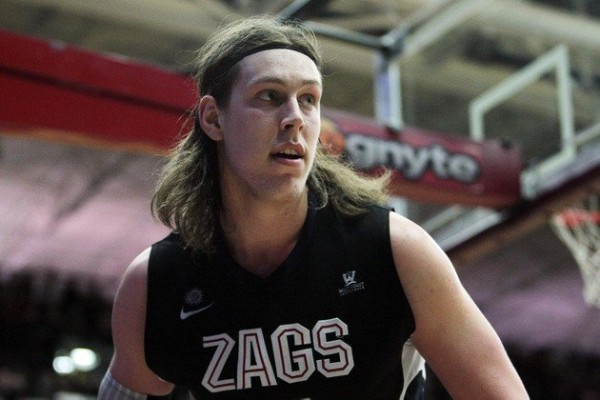Assessing Gonzaga’s Long-Term Prospects
Posted by AMurawa on February 1st, 2013Andrew Murawa is an RTC correspondent. He filed this report after Thursday night’s game between Gonzaga and Loyola Marymount in Los Angeles.
Here’s a tip. Gonzaga is good. Real good. Also water is wet, basketballs are round, and Kelly Olynyk’s long hair and head band combination is a, well, “interesting” look. But with the Zags now 20-2 overall and 7-0 in the WCC after drilling Loyola Marymount on the road Thursday night, and with rankings (both computer and human) placing them in or near the top 10 nationally, just how good is Mark Few’s team compared with this year’s batch of nationally relevant teams, and just how good are they compared to teams in the school’s recent history?

Kelly Olynyk’s Breakout Year Has Gonzaga As One Of The Nation’s Elite Offensive Teams (USA Today Sports Images)
The first question first: offensively, the Zags are at least in the same conversation as some of the elite offensive teams in the nation. Gonzaga is one of five teams in the country with an adjusted offensive efficiency at 120 or higher; the other four are Michigan, Florida, Indiana, and Creighton. And make no mistake, the Bulldogs are every bit as capable of putting the ball in the hoop in a variety of different ways as any of those teams. Olynyk’s breakout season has put him on the National Player of the Year radar, and at 7’0”, he’s an inside-outside threat who is a walking offensive mismatch. Senior Elias Harris has been on the national radar so long, he’s probably taken for granted at this point, but he’s having his best season of a remarkably consistent career; and paired with Olynyk, he is even more impressive. We’ll even just glance over guys like Sam Dower and Przemek Karnowski (efficient, physical threats themselves) on our way to discussing a talented backcourt. Between Kevin Pangos and Gary Bell (who knocked in five of his six first-half attempts from deep), you have one of the better three-point shooting backcourt tandems this side of Hinkle Fieldhouse (sorry Zag fans, you probably didn’t want to read those two words so soon). Throw in a ton of depth (including playmaker David Stockton and all-glue-guy Mike Hart) and Few has no shortage of options.
One significant concern, however, about the Zags, and one that certainly wasn’t tested by LMU and may not be tested again during the remainder of the WCC schedule, is how well Gonzaga can deal defensively with more athletic and bigger guards. Against Illinois (one of the two losses on the record books), Brandon Paul regularly abused whichever guard Gonzaga threw at him on his way to 35 points. D.J. Richardson and Tracy Abrams combined to add 25 more. Against Oklahoma State (a one-point Gonzaga win that could have easily gone the other way), big athletic guards Marcus Smart and Markel Brown combined for 39 points, while regularly setting up shooter Phil Forte on his way to five three-pointers. Evan Santa Clara managed to keep things close on the back of 29 points from Kevin Foster. Not that Olynyk is by any means a lock-down defender in the frontcourt, but the ability of Gonzaga’s backcourt to slow down NCAA Tournament-quality backcourts will remain a question until the Zags actually do it. As good as the Zags have been offensively, a defensive efficiency rating of #41 in the nation proves that they have nowhere near the balance from offense to defense that a fellow elite offensive team like Florida has. For that matter, they are not even in the same ballpark as Indiana (#15 nationally); they are somewhere between Michigan (#33) and Creighton (#86). Doubts about this team’s ability to get key stops against good teams when needed in March are not unfounded.
The other question is, how good is this Gonzaga team compared with their predecessors? My first instinct was to go back to the 2006 Adam Morrison-led team, but I think going back to just 2009 and the Jeremy Pargo/Josh Heytvelt/Matt Bouldin-led squad finds a team superior to this one. Aside from an ugly an inexplicable home non-conference loss to Portland State (a team that made the NCAA Tournament), that team’s four other regular season losses were in overtime to the Hasheem Thabeet/A.J. Price Final Four Connecticut team, a Utah team that tied for the Mountain West regular season title, the Chase Budinger-led Arizona Sweet Sixteen team and a midseason blowout loss against Tyreke Evans’ Memphis squad (Sweet Sixteen). That Gonzaga team, which swept through the WCC in much the same way this team is threatening to do, was pretty similarly impressive offensively and more or less identical to this team defensively. That Zag team earned a four-seed and had the misfortune in the Sweet Sixteen of running up against the Tyler Hansborough/Ty Lawson team that eventually won the national title. Predictably, and like every other team that Tar Heels faced in that tourney, the Bulldogs were run off the court, falling by 19. The good news is that (well aside from the fact that there is nothing like that UNC team this year) if this Gonzaga team can get through the WCC regular season slate undefeated and win the WCC Tournament like that 2009 team did, they will likely be a strong contender for a #2 seed this time around. They will still be likely to run up against a team in the Sweet Sixteen that can give them problems, but this looks very much like a team that could make the Elite Eight. And, once you get that far, as we have seen before, anything can happen. While this Gonzaga team doesn’t have the look of a traditional national championship contender, the fact is, there are very few teams this season that do.










































